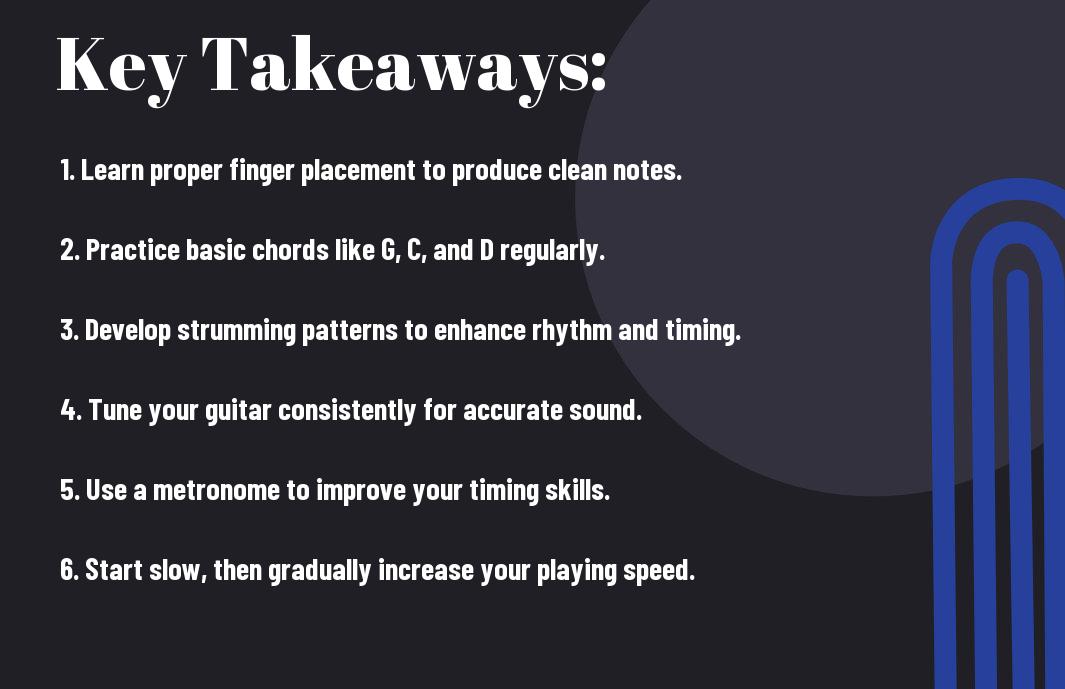Basics of guitar playing can seem daunting at first, but I’m here to guide you through the necessarys. Understanding your instrument, from its parts to basic chords, is key to creating beautiful music. I’ll share tips on how to properly hold your guitar, tune it, and the importance of practice in developing your skills. Let’s initiate on this musical journey together, ensuring you build a strong foundation that will enhance your playing experience and keep you motivated as you progress.

Strumming Secrets: The Foundation of Rhythm
Strumming acts as the heartbeat of your guitar playing, creating the rhythm that supports melodies. By mastering various strumming techniques, you’ll find that your ability to play any song dramatically improves. Each strum contributes not just to the sound, but also to the feel of the music. When you focus on rhythm, you unlock the door to greater creativity and expression in your guitar practice. These strumming patterns will form the backbone of your style and help you groove along with your favorite tracks.
The Essential Strumming Patterns for Beginners
Starting with basic strumming patterns such as down-down-up-up-down-up can significantly improve your rhythm skills. As you practice, stress the importance of consistency in your strokes, as this will create a solid rhythmic foundation. Gradually, you can experiment with more complex patterns, including syncopation and accents, to develop your unique sound. Practicing these patterns with a metronome will help you stay in time and build your confidence.
Timing and Tempo: Mastering the Beat
Keeping time accurately is the backbone of good music. Mastering your timing and tempo involves understanding how to feel the beat and translate it into your strumming. Play along with a metronome or drumming track to help internalize the steady pulse of music.
Using a metronome, maintain a steady pace that suits your current skill level. Start slow to accurately gauge how each strum aligns with the beat, then gradually increase the tempo as you become more comfortable. Playing too fast can lead to sloppy strumming, while a slower pace allows you to hone your accuracy. Aim to recognize how different tempos affect the feel of the music—slow tempos may evoke thoughtfulness, while faster paces infuse energy. Developing this awareness will elevate your playing and make your music more dynamic.
Chord Craftsmanship: Building Your Musical Vocabulary
Mastering chords is fundamental in your guitar journey, as they form the backbone of countless songs. I always find that the more chords you learn, the more expressive your playing can become. By incorporating various chord shapes and sounds, your musical vocabulary expands, allowing you to communicate emotions through music effortlessly. As you become comfortable with the vital chords, you’ll discover new ways to enhance your playing and even create original compositions.
The Most Common Chords Every Beginner Should Learn
Focusing on a few key chords can significantly impact your progress as a beginner. I recommend starting with the C, G, D, A, and E major chords, as these are the basis for numerous popular songs. Incorporating a couple of minor chords, like A minor and E minor, will further enrich your repertoire. With practice, you’ll find your fingers becoming more adept at forming these shapes and transitioning between them smoothly.
The Power of Transitions: Moving Between Chords Seamlessly
Seamless transitions between chords elevate your playing experience, making songs sound fluid and polished. To achieve this, I suggest starting with two chords and repeatedly switching between them until you feel comfortable. Gradually add more chords and focus on minimizing any pauses or hesitations. Practicing these transitions regularly will train your fingers and improve muscle memory, enabling you to switch chords effortlessly.
This practice allows for a natural flow in your playing, which is incredibly fulfilling. As you transition from one chord to the next, pay attention to your finger positioning; even a slight adjustment can make a significant difference. Using a metronome can help maintain a steady tempo, making your practice more effective. Once you become proficient in simple transitions, you can progress to more complex patterns and songs, fostering your overall musicality and confidence.
Tuning Tactics: Ensuring Your Guitar Sounds Its Best
Getting your guitar in tune is crucial for a satisfying playing experience. The sound of an out-of-tune guitar can be jarring and can hinder your progress as you practice. Invest time in understanding the various tuning techniques available, from using an electronic tuner to tuning by ear. Regularly checking and adjusting your guitar can help you develop a deeper connection with your instrument, ensuring it always sounds its best.
Different Tuning Methods Explained
Tuning your guitar can be achieved through several methods. An electronic tuner is one of the most popular tools, providing accurate pitches that make tuning easy. Alternatively, you can use a tuning fork or a piano to match pitch, or even employ the relative tuning method, where you tune against the sixth string (E) and then adjust the others accordingly. For more advanced players, drop tunings or open tunings can create unique sounds and styles.
The Importance of Regular Maintenance and Gear Checks
Maintaining your guitar’s health involves more than just tuning. Regular checks for string wear, neck relief, and intonation are necessary for optimal performance. Keep an eye on your strings and change them regularly; old strings can sound dull and lifeless. Additionally, ensure that the hardware—like tuners and bridge systems—are functioning properly. These small maintenance chores can significantly affect your overall sound quality and playing experience.
Staying vigilant about maintenance can prevent minor issues from escalating into bigger problems. A simple string change can revive a tired guitar, while a quick check of the tuning pegs can help avoid frustrating tuning slips during practice or performance. Moreover, adopting a set routine for gear checks allows you to develop a deeper understanding of your instrument’s needs. By doing this, you’re not only preserving your guitar but also enhancing your musical journey—each note more vibrant and resonant than the last.
The Art of Finger Positioning: Technique Over Tradition
Finger positioning plays a vital role in how you play and feel while using the guitar. While many instructors may lean towards traditional finger placement methods, I believe that adapting your technique to support your unique hand shape and comfort can lead to better results. Prioritizing technique over strict adherence to tradition allows you to develop a more fluid playing style, enabling you to express your own musical voice. Let’s look into how to find the best finger placements that suit you.
The Key to Proper Finger Placement and Hand Position
Proper finger placement can significantly impact your playing experience, helping you to navigate the fretboard with ease. Focus on keeping your fingers curved and pressing down on the strings with the tips, which allows for clear sound without unwanted buzzing. Position your thumb behind the neck of the guitar to create a solid grip, and maintain a relaxed wrist to prevent strain. Every time you play, pay attention to your hand’s posture—it should feel comfortable, like a natural extension of your body.
Overcoming Challenges: Building Strength and Flexibility
Building finger strength and flexibility is an crucial part of your development as a guitarist. Engaging in dedicated exercises can help you overcome stiffness and improve your agility. Incorporating scales and finger drills into your practice routine will not only strengthen your fingers but also enhance your overall dexterity. In my experience, regular warm-up sessions focusing on finger stretching and movement can make a significant difference in your playing comfort and quality.
Embarking on exercises like chromatic scales or finger independence drills can yield tremendous benefits. For instance, practicing the 1-2-3-4 exercise—where you play each finger on a different fret in ascending and descending order—strengthens both your fingers and your coordination. I found that dedicating just 10 minutes a day to these exercises dramatically increased my finger strength within a month, allowing me to tackle more complex chords and solos with ease. It’s all about creating a consistent practice habit and recognizing that every small improvement contributes to your overall progress.
The Beginner’s Mindset: Cultivating Patience and Practice
Embracing the beginner’s mindset is necessary for any aspiring guitarist. This approach helps to cultivate patience and growth, acknowledging that mastery takes time and effort. Instead of fixating on perfection, focus on small victories, and allow yourself the space to learn and evolve. Engaging with communities like [newbie] what are the basics every guitarist should master …] can also provide valuable insights and encouragement as you navigate your journey.
Creating a Consistent Practice Routine
Designing a consistent practice routine is key to progress. I suggest allocating a specific time each day to play, even if it’s just 15–30 minutes. This regularity not only builds muscle memory but also reinforces your commitment to learning. Find a quiet space free from distractions and make your practice a non-negotiable part of your daily schedule.
Finding Motivation: Setting Realistic Goals and Milestones
Motivation becomes easier to maintain when you set realistic goals and celebrate your achievements along the way. Break down your guitar learning into manageable milestones, like mastering a specific chord or learning a short song. By focusing on small, achievable targets, you keep your enthusiasm high and create a tangible sense of progress. I often recommend tracking your journey visually, perhaps with a checklist or a practice journal, making it rewarding to look back at your development over time.
Establishing realistic goals is more than just aiming for the stars; it’s about understanding your current abilities and celebrating every step along the path. Think of goals as stepping stones rather than high walls. For instance, rather than declaring, “I will play like a pro in a year,” try, “I will master the first five chords this month.” Each time I reach one of these milestones, I feel a sense of accomplishment that fuels my passion for the instrument. This approach makes the journey enjoyable and keeps motivation flowing.
To wrap up
With this in mind, I hope this overview of guitar basics for beginners has provided you with the foundational knowledge you need to start your musical journey. You’ve learned about different guitar types, important techniques, and the importance of practice. As you pick up your guitar, keep in mind that patience and persistence will be your best friends as you develop your skills. Embrace the learning process, and soon you’ll find yourself playing the music you love!




